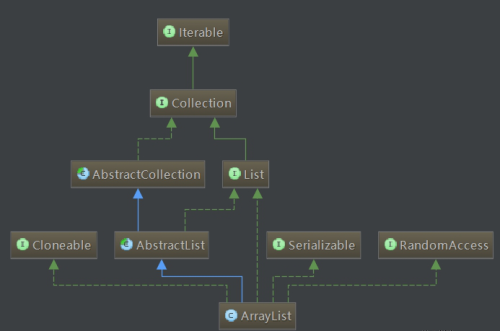C# ArrayList的用法
阿新 • • 發佈:2017-11-02
知新樹 寧金峰
將集合中的某個元素插入ArrayList的指定索引處
ArrayList list2=new ArrayList();
list2.Add("tt");
list2.Add("ttt");
aList.InsertRange(2,list2);
結果為abtttttcde
四、刪除
a)public virtual void Remove(object obj);
從ArrayList中移除特定對象的第一個匹配項,註意是第一個
aList.Remove("a");
結果為bcde
2.public virtual void RemoveAt(intindex);
移除ArrayList的指定索引處的元素
aList.RemoveAt(0);
結果為bcde
3.public virtual void RemoveRange(int index,int count);
從ArrayList中移除一定範圍的元素。Index表示索引,count表示從索引處開始的數目
aList.RemoveRange(1,3);
結果為ae
4.public virtual void Clear();
從ArrayList中移除所有元素。
五、排序
a)public virtual void Sort();
對ArrayList或它的一部分中的元素進行排序。
DropDownList1.DataSource=aList;//DropDown ListDropDownList1;
DropDownList1.DataBind();
結果為eabcd
aList.Sort();//排序
DropDownList1.DataSource=aList;//DropDownListDropDownList1;
DropDownList1.DataBind();
結果為abcde
b)public virtual void Reverse();
將ArrayList或它的一部分中元素的順序反轉。
aList.Reverse();//反轉
DropDownList1.DataSource=aList;//DropDownListDropDownList1;
DropDownList1.DataBind();
結果為edcba
六、查找
a)public virtual int IndexOf(object);
b)public virtual int IndexOf(object,int);
c)public virtual int IndexOf(object,int,int);
返回ArrayList或它的一部分中某個值的第一個匹配項的從零開始的索引。沒找到返回-1。
intnIndex=aList.IndexOf(“a”);//1
nIndex=aList.IndexOf(“p”);//沒找到,-1
d)public virtual int LastIndexOf(object);
e)public virtual int LastIndexOf(object,int);
f)public virtual int LastIndexOf(object,int,int);
返回ArrayList或它的一部分中某個值的最後一個匹配項的從零開始的索引。
intnIndex=aList.LastIndexOf("a");//值為2而不是0
g)public virtual bool Contains(objectitem);
確定某個元素是否在ArrayList中。包含返回true,否則返回false
七、獲取數組中的元素
下面以整數為例,給出獲取某個元素的值的方法
ArrayList aList=new ArrayList();
for(int i=0;i<10;i++)
aList.Add(i);
for(i=0;i<10;i++)
Textbox1.text+=(int)aList[i]+" ";//獲取的方式基本與一般的數組相同,使用下標的方式進行
結果為:0 1 2 3 4 5 6 7 8 9
八、其他
1.public virtual intCapacity{get;set;}
獲取或設置ArrayList可包含的元素數。
2.public virtual intCount{get;}
獲取ArrayList中實際包含的元素數。
Capacity是ArrayList可以存儲的元素數。Count是ArrayList中實際包含的元素數。Capacity總是大於或等於Count。如果在添加元素時,Count超過Capacity,則該列表的容量會通過自動重新分配內部數組加倍。
如果Capacity的值顯式設置,則內部數組也需要重新分配以容納指定的容量。如果Capacity被顯式設置為0,則公共語言運行庫將其設置為默認容量。默認容量為16。
在調用Clear後,Count為0,而此時Capacity切是默認容量16,而不是0
3.public virtual void TrimToSize();
將容量設置為ArrayList中元素的實際數量。
如果不向列表中添加新元素,則此方法可用於最小化列表的內存系統開銷。
若要完全清除列表中的所有元素,請在調用TrimToSize之前調用Clear方法。截去空ArrayList會將ArrayList的容量設置為默認容量,而不是零。
ArrayList aList=new ArrayList();
aList.Add("a");
aList.Add("b");
aList.Add("c");
aList.Add("d");
aList.Add("e");//Count=5,Capacity=16,
aList.TrimToSize();//Count=Capac
ArrayList類是一個特殊的數組。通過添加和刪除元素,就可以動態改變數組的長度。
一、優點
1. 支持自動改變大小的功能
2. 可以靈活的插入元素
3. 可以靈活的刪除元素
4. 可以靈活訪問元素
二、局限性
跟一般的數組比起來,速度上差些
用微軟的話講:
“添加到 ArrayList 中的任何引用或值類型都將隱式地向上強制轉換為 Object。如果項是值類型,則必須在將其添加到列表中時進行裝箱操作,在檢索時進行取消裝箱操作。強制轉換以及裝箱和取消裝箱操作都會降低性能;在必須對大型集合進行循環訪問的情況下,裝箱和取消裝箱的影響非常明顯。”
ArrayList繼承關系圖

三、添加元素
1.public virtual int Add(object value);
將對象添加到ArrayList的結尾處
ArrayList aList=new ArrayList();
aList.Add("a");
aList.Add("b");
aList.Add("c");
aList.Add("d");
aList.Add("e");
內容為abcde
2.public virtual void Insert(int index,object value);
將元素插入ArrayList的指定索引處
aList.Insert(0,"aa");
結果為aaabcde
3.public virtual void InsertRange(int index,ICollectionc);
將集合中的某個元素插入ArrayList的指定索引處
ArrayList list2=new ArrayList();
list2.Add("tt");
list2.Add("ttt");
aList.InsertRange(2,list2);
結果為abtttttcde
四、刪除
a)public virtual void Remove(object obj);
從ArrayList中移除特定對象的第一個匹配項,註意是第一個
aList.Remove("a");
結果為bcde
2.public virtual void RemoveAt(intindex);
移除ArrayList的指定索引處的元素
aList.RemoveAt(0);
結果為bcde
3.public virtual void RemoveRange(int index,int count);
從ArrayList中移除一定範圍的元素。Index表示索引,count表示從索引處開始的數目
aList.RemoveRange(1,3);
結果為ae
4.public virtual void Clear();
從ArrayList中移除所有元素。
五、排序
a)public virtual void Sort();
對ArrayList或它的一部分中的元素進行排序。
DropDownList1.DataSource=aList;//DropDown ListDropDownList1;
DropDownList1.DataBind();
結果為eabcd
aList.Sort();//排序
DropDownList1.DataSource=aList;//DropDownListDropDownList1;
DropDownList1.DataBind();
結果為abcde
b)public virtual void Reverse();
將ArrayList或它的一部分中元素的順序反轉。
aList.Reverse();//反轉
DropDownList1.DataSource=aList;//DropDownListDropDownList1;
DropDownList1.DataBind();
結果為edcba
六、查找
a)public virtual int IndexOf(object);
b)public virtual int IndexOf(object,int);
c)public virtual int IndexOf(object,int,int);
返回ArrayList或它的一部分中某個值的第一個匹配項的從零開始的索引。沒找到返回-1。
intnIndex=aList.IndexOf(“a”);//1
nIndex=aList.IndexOf(“p”);//沒找到,-1
d)public virtual int LastIndexOf(object);
e)public virtual int LastIndexOf(object,int);
f)public virtual int LastIndexOf(object,int,int);
返回ArrayList或它的一部分中某個值的最後一個匹配項的從零開始的索引。
intnIndex=aList.LastIndexOf("a");//值為2而不是0
g)public virtual bool Contains(objectitem);
確定某個元素是否在ArrayList中。包含返回true,否則返回false
七、獲取數組中的元素
下面以整數為例,給出獲取某個元素的值的方法
ArrayList aList=new ArrayList();
for(int i=0;i<10;i++)
aList.Add(i);
for(i=0;i<10;i++)
Textbox1.text+=(int)aList[i]+" ";//獲取的方式基本與一般的數組相同,使用下標的方式進行
結果為:0 1 2 3 4 5 6 7 8 9
八、其他
1.public virtual intCapacity{get;set;}
獲取或設置ArrayList可包含的元素數。
2.public virtual intCount{get;}
獲取ArrayList中實際包含的元素數。
Capacity是ArrayList可以存儲的元素數。Count是ArrayList中實際包含的元素數。Capacity總是大於或等於Count。如果在添加元素時,Count超過Capacity,則該列表的容量會通過自動重新分配內部數組加倍。
如果Capacity的值顯式設置,則內部數組也需要重新分配以容納指定的容量。如果Capacity被顯式設置為0,則公共語言運行庫將其設置為默認容量。默認容量為16。
在調用Clear後,Count為0,而此時Capacity切是默認容量16,而不是0
3.public virtual void TrimToSize();
將容量設置為ArrayList中元素的實際數量。
如果不向列表中添加新元素,則此方法可用於最小化列表的內存系統開銷。
若要完全清除列表中的所有元素,請在調用TrimToSize之前調用Clear方法。截去空ArrayList會將ArrayList的容量設置為默認容量,而不是零。
ArrayList aList=new ArrayList();
aList.Add("a");
aList.Add("b");
aList.Add("c");
aList.Add("d");
aList.Add("e");//Count=5,Capacity=16,
aList.TrimToSize();//Count=Capac
本文出自 “13233523” 博客,請務必保留此出處http://13243523.blog.51cto.com/13233523/1978436
C# ArrayList的用法
